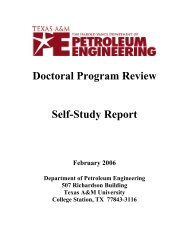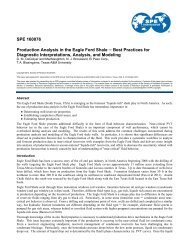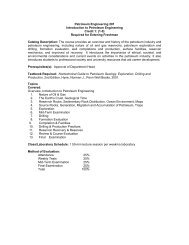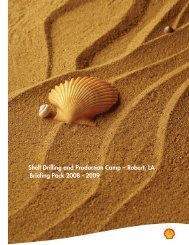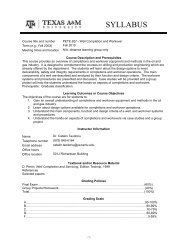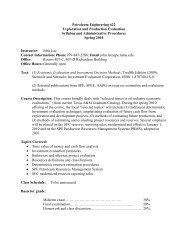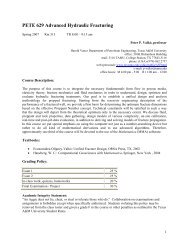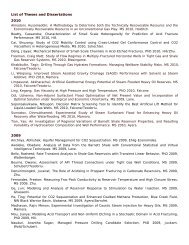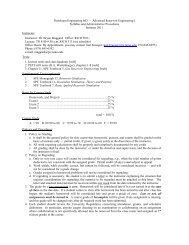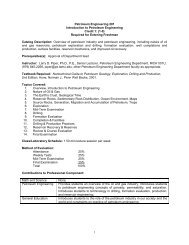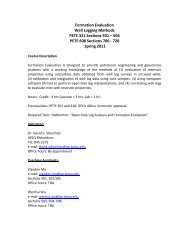Crisman Annual Report 2009 - Harold Vance Department of ...
Crisman Annual Report 2009 - Harold Vance Department of ...
Crisman Annual Report 2009 - Harold Vance Department of ...
You also want an ePaper? Increase the reach of your titles
YUMPU automatically turns print PDFs into web optimized ePapers that Google loves.
Characterization <strong>of</strong> Rock Transport Properties in Tight Gas and Shale<br />
Objectives<br />
The objective <strong>of</strong> this work is to determine transport<br />
properties such as permeability, porosity, and<br />
fracture characteristics in very low permeability<br />
rocks such as tight gas sandstone and shale. Further,<br />
we would be characterizing stress-induced changes<br />
in permeability in these low permeability rocks.<br />
This would be done using the pulse permeameter<br />
and steady-state measurements using under<br />
triaxial stress. Generally, “Pressure Pulse Test”<br />
is recommended in tight gas and shale reservoirs<br />
instead <strong>of</strong> conventional “Steady State Permeability<br />
Test”. The “Pressure Pulse Permeameter” machine<br />
in Rock Mechanics Lab can be a good tool for<br />
determining rock properties.<br />
permeability/porosity check plugs to make sure the<br />
values are precise. After calibrations and validations,<br />
we will be ready to measure permeability/porosity<br />
<strong>of</strong> the tight core samples.<br />
Approach<br />
During this month and the last month, we focused<br />
on the accuracy <strong>of</strong> the transducers and found out<br />
that a part <strong>of</strong> the measured leakage rate came from<br />
the fluctuations in the outputs <strong>of</strong> the transducers.<br />
The downstream differential transducer had a larger<br />
rate <strong>of</strong> fluctuations. We tested the leakage rate<br />
in different system pressures using impermeable<br />
core plugs and determined that the leakage rates<br />
in upstream and downstream transducers are<br />
consistent, which means the leakage comes from a<br />
point which connects both sections.<br />
Accomplishments<br />
To reduce the data fluctuation in the downstream<br />
part, we changed the downstream transducer, then<br />
calibrated and tested again. The leakage rate in the<br />
downstream part decreased from 1.6 psi/hr to ~ 1.1<br />
psi/hr. Then, since the shortest route that connects<br />
upstream and downstream sections to each other is<br />
the core holder, we inspected the core holder again<br />
and wrapped the outer diameter <strong>of</strong> the rubber sleeve<br />
inside the core holder with extra aluminum foil. It<br />
covered the torn parts <strong>of</strong> the previously wrapped<br />
foil, which had been generated due to shrinkage and<br />
extension <strong>of</strong> the rubber sleeve. With these changes<br />
made, we tested the leakage and the rates were<br />
now 0.3 psi/hr for upstream and 0.36 psi/hr for<br />
downstream, which are reasonable.<br />
Future Work<br />
Since the machine has had several changes and<br />
manipulations, for the next month we should calibrate<br />
the volumes and (if possible) test it with known<br />
Project Information<br />
1.2.6 Transport Properties Characterization <strong>of</strong> Tight Gas<br />
Shales<br />
Contacts<br />
Ahmad Ghassemi<br />
979.845.2206<br />
ahmad.ghassemi@pe.tamu.edu<br />
Vahid Serajian<br />
CRISMAN INSTITUTE<br />
22<br />
<strong>Crisman</strong> <strong>Annual</strong> <strong>Report</strong> <strong>2009</strong>



